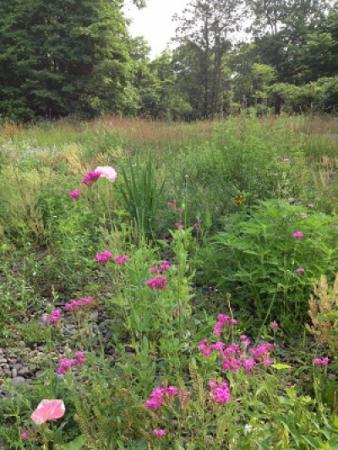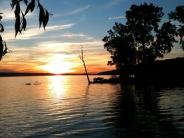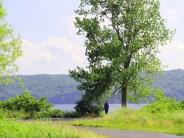Reforestation of this industrialized site has occurred at Salt Point since 1962 when the International Salt Company factory on site burned and the rubble and remaining buildings were raised. The property was donated to the NY State Department of Environmental Conservation and has been slowly reforesting through successional growth and sporadic community interest in planting. More recently, the Town of Lansing and volunteers allocated limited funds to purchase appropriate adaptive and native plants for planting on the site in hopes of returning the site to a more ecologically diverse habitat that could support a greater diversity of animal species.
Salt Point is a triangular wide peninsula bordered by Salmon Creek and Cayuga Lake. It has been colonized primarily by species of trees and shrubs that disperse via wind, water, and animals. Typically, flood plain bottomland would have a large quantity of sycamore, cottonwood, poplar, willow, red, sugar, and moose maples, birches, box elder, beech, mulberry, paw paw, swamp white oak, hop hornbeam, bitternut and shagbark hickory, to name a few.
Because Salt Point was a factory site for so many years, the diversity of plant life has been slowly recovering. Deer browse is predominant and restricts growth of apple, dogwood, juniper, pine, and certain other species. The slope east of the railroad bed is much more diverse in nature, being adjacent to less disturbed slope habitats that share pollen and seeds for a more rapid succession process. Plant species are colored blue for dominant, green for emergent, red for invasive, and black for desired plants we'd like to see added. Visitors can bring acorns and hickory nuts and plant them on the upper slopes, also along meadow edge near the blocks for a traffic buffer. New plantings are shown as (month, year).
Trees
|
Dominant
|
Emergent |
Invasive |
Desired |
|
Black Locust
|
Honey Locust |
Common Buckthorn |
|
|
Black Willow
|
Weeping Willow |
|
Red Pine |
|
Box Elder
|
Pussy Willow |
|
Flowering Dogwood |
|
Cottonwood
|
Red Maple (2-2013, 4-2014) |
|
White Oak |
|
Poplar
|
Silver maple (2-2013) |
|
Red Oak |
|
Sumac
|
Kentucky Coffee Tree (5-2013) |
|
Black Oak |
|
Black Walnut
|
Tulip Poplar (2-2013, 5-2014) |
|
Shag Bark Hickory |
|
Red Cedar Juniperus virginiana
|
Redbud (2-2013) |
|
Pignut Hickory |
|
Scotch Pine
|
Common Apple |
|
Hornbeam |
|
Choke cherry (1-2014)
|
Hawthorne ‘Winter King’ (1-2014) |
|
Hophornbeam |
|
Black Cherry
|
Crab Apple (1-2014) |
|
Black Birch |
|
American Elm
|
Butternut |
|
Yellow Birch |
| Slippery Elm |
White Pine (4-2013) |
|
Sassafras |
| |
Norway Spruce (2013)
|
|
Flowering Dogwood |
| |
Sweet Cherry (1-2013)
|
|
Pagoda Dogwood (C. alternifolia) |
| |
Catalpa (2-2013)
|
|
Beech |
| |
Mulberry
|
|
Paw Paw |
| |
American Sycamore
|
|
|
| |
River Birch (14-2014) |
|
|
| |
Swamp White Oak (6-2013) |
|
|
| |
Witch Hazel Hamamelis virginiana (3-2013) |
|
|
| |
Green Ash (6- 2013) |
|
|
| |
Shad bush Amelanchier (5-2014) |
|
|
| |
Black Gum Nyssa sylvatica (1-2013) |
|
|
| |
Sugar Maple
|
|
|
| |
Sweet Bay Magnolia
|
|
|
| |
American Linden (Basswood)
|
|
|
| |
Black Oak
|
|
|
| |
Horse Chestnut |
|
|
| |
Moose Maple
|
|
|
Shrubs
|
Dominant
|
Emergent |
Invasive |
Desired |
|
Red Twig Dogwood
|
Chokeberry (5-2013) |
Japanese honeysuckle |
Winterberry Holly (Ilex verticillata) |
|
Silky Dogwood (40-2013)
|
Virginia Rose (5-2013) |
European privet |
Spice Bush |
|
Ninebark Physocarpus op. (2-2013, 3-2014)
|
Bayberry (4-2013) |
Autumn olive |
Sweet Shrub |
|
Bristly Locust Robinia hispida
|
Cranberry Viburnum (18-2013) |
Multiflora Rose |
Summersweet (Clethra) |
|
Black-capped Raspberry
|
Burkwood Viburnum V. carlesii x V. utile (2- 2014) |
|
|
|
Blackberry
|
Arrowwood Viburnum V. dentatum (1- 2014) |
|
|
Vines
|
Dominant
|
Emergent |
Invasive |
Desired |
|
Poison Ivy
|
|
Virginia Creeper |
|
| |
|
Wild Grape |
|
Herbaceous
Local wildflowers that existed before seeding are species that establish in disturbed areas: Queen Anne’s Lace, Bird’s Foot Trefoil, Butterfly Weed, Chickory, Crimson Clover, Dame’s Rocket, New England Aster, Daisy Fleabane, Milkweed, Burdock, Goldenrod, Common Daisy, Common Mullein, Coltsfoot, Equisetum (scouring horsetail), sensitive fern, wild strawberry, nettle, dock, cocklebur, chamomile, spearmint. Invasive: Crown Vetch. Needed herbaceous: May Apple, Trout Lily, Blood Root, Trillium, Jack in the Pulpit, Skunk Cabbage, Various Ferns, Trout lily, Marsh Marigold.
In 2013, two acres of wildflower seeds were spread throughout Salt Point. The best establishment occurred on the North facing beaches and in the drier East Meadow. The seeds were purchased from ‘American Meadows’ online. The North East Wildflower Mix was ordered containing 27 different wildflowers. The mix contained annual and perennial wildflowers:
Calendula, Cornflower / Bachelor Button, Siberian Wallflower, Shasta Daisy, Lance-Leaf Coreopsis, Plains Coreopsis, Sulphur Cosmos, Wild Cosmos, Larkspur Giant Imperial Mixture, Sweet William, Purple Coneflower, California Poppy, Blanket Flower, Baby's Breath, Dwarf Sunflower Sunspot, Candytuft, Rose Mallow, Scarlet Flax, Blue Flax, Wild Lupine, Love In A Mist (Nigella), Baby Blue Eyes, Red Poppy/Shirley Poppy, Yellow Prairie Coneflower, Gloriosa Daisy, Black-eyed Susan, Catchfly
Attracting Butterflies: In 2014, new varieties of wildflowers were seeded into recently mowed and disturbed areas on the west end of Salt Point with a focus on plants that will support monarch butterfly populations during their life span and migration activities. These include: Butterfly milkweed, Swamp milkweed, Common milkweed, Purple coneflower, Joe Pye weed, Indian blanket, Scarlet sage, Tithonia torch, Zinnia.
Control needed: Tansy Ragwort, Canada Thistle, Japanese knotweed, Black swallow-wort, Common Reed Phragmites, Hog weed



